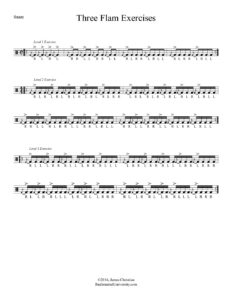
Three levels of snare exercises are presented here:
The first level focuses on basic flam rudiments—the flam, the flam tap, and the flam paradiddle. It’s a great exercise for younger players. Use the single flams to focus on great flam spacing, then utilize the same foundational motion to lead into the flam taps. (A flam and flam tap are very similar; simply add an extra note after the initial flam.) The transition between flam paradiddles is the same as the double in a flam tap, so each of the three rudiments build off of each other. The exercise is written in cut time to emphasize that it can be taken in a faster “two” feel once you feel comfortable with it. For young players, however, it would be better to start it in a slow 4/4. Once this exercise is solid, you can move on to the second level.
The second level exercise also utilizes flam taps and paradiddles, but flam accents are heavily incorporated in the first two measures. These three rudiments are the most common flam rudiments, and being able to play patterns like this is an important skill to achieve for any snare drummer or percussionist. (Note: This second exercise is not original with me. I played it regularly in my high school drum line under the instruction of Rick Beckham. It’s a really good exercise though, and it’s worth passing along.)
The third level exercise follows the same accent pattern as the previous exercise, but the coordinative complexity is increased. All of the flam rudiments are inverted lead-hand switch patterns. The flam taps are now inverted flam taps. The other patterns don’t have names that are universally agreed upon, but I like calling them inverted flam accents and inverted flam fours.
All of these exercises are good tests of flam coordination. As you practice them, always keep the grace notes low and close to the drum head. Make a distinction between accented and non-accented notes. As always, make sure your flams are consistent with proper spacing.
Happy flamming!
